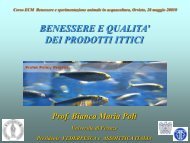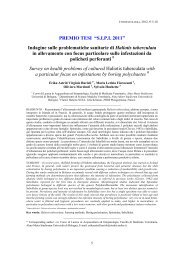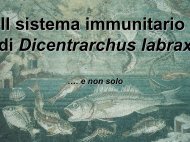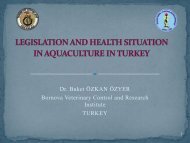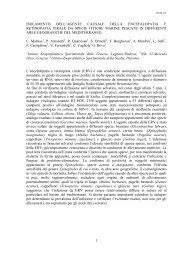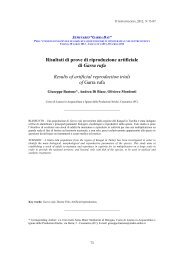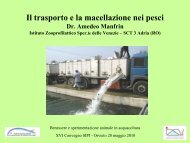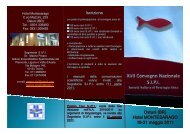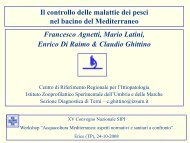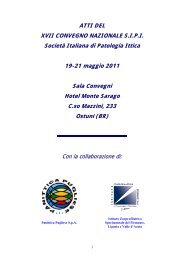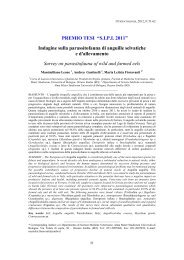ATTI DEL XV CONVEGNO NAZIONALE SIPI Società Italiana di ...
ATTI DEL XV CONVEGNO NAZIONALE SIPI Società Italiana di ...
ATTI DEL XV CONVEGNO NAZIONALE SIPI Società Italiana di ...
- No tags were found...
Create successful ePaper yourself
Turn your PDF publications into a flip-book with our unique Google optimized e-Paper software.
Abstract Workshop<br />
LEGISLATION AND HEALTH MANAGEMENT AQUACULTURE IN ISRAEL<br />
Angelo COLORNI<br />
National Center for Mariculture of the Israel Oceanographic and Limnological Research,<br />
Eilat, Israel. Head of the Pathobiology Department.<br />
There is no single aquaculture statute governing fish farming in Israel. However, general<br />
regulations, standards, codes of practice and policies aimed at minimizing pollution of<br />
rivers, lakes, reservoirs, aquifers, and the sea - under the juris<strong>di</strong>ction of the Israeli Ministry<br />
for Environmental Protection - all apply. Fish farmers frequently apply to the Fishery<br />
Department of the Ministry of Agriculture for permission to introduce new species or<br />
genetically improved species, to increase production, satisfy market demand and generate<br />
export options. A special Introduction Committee (under the patronage of the Dept. of<br />
Fisheries & Aquaculture – Min. Agriculture) issues the permit for a particular introduction<br />
or vetoes it whenever there is concern that the species in question may adversely affect<br />
local ecosystems (Lake Kinneret and the Gulf of Eilat in particular).<br />
Predation, competition, genetic impoverishment and <strong>di</strong>sease are the parameters considered<br />
for ecological impact.<br />
The aquaculture industry in Israel is highly developed (20,000 tons of fish - approximately<br />
one third of the fish consumed in the country - are produced annually in ponds and<br />
reservoirs over a total area of 3000 hectares) and is based almost entirely on science-linked<br />
technologies. A two-way flow of information between researchers and farmers exists, with<br />
Government agencies, academic institutions, industry and cooperative bo<strong>di</strong>es working<br />
together to seek solutions and meet new challenges. Through a network of extension<br />
services, problems in the field are brought <strong>di</strong>rectly to the researchers for solutions, and<br />
scientific results are quickly transmitted to the field for trial adaptation and<br />
implementation. Diaminostilbene derivatives, used as fluorescent whitening agents in the<br />
textile industry, were found to be therapeutically effective and environment-friendly in the<br />
control of Saprolegnia, an opportunistic saprotrophic aquatic mold and a constant concern<br />
in freshwater ponds in the north of the country during winter, while Prymnesium parvum,<br />
an ichthyotoxic flagellated microalga that recently re-appeared in Israel in closed<br />
circulation systems in the south, is controlled by ammonium sulfate.<br />
Despite the strong support received by the Government, after an expansion peak in the<br />
1970s fish farming sharply declined as a consequence of the chronic shortage of fresh<br />
water in the country. In ad<strong>di</strong>tion, following a decade-long controversy, the Government<br />
ruled to <strong>di</strong>scontinue fish farming in the Red Sea near the southern city of Eilat by 2008<br />
because it was deemed damaging to nearby coral reefs. Attempts are being made to<br />
compensate for this situation by developing technologically advanced, storm-resistant<br />
submersible cages in the Me<strong>di</strong>terranean Sea, expan<strong>di</strong>ng brackish water aquaculture,<br />
investigating the suitability of geothermal water to aquaculture, encouraging the practice of<br />
polyculture, and employing closed systems of recirculated water.<br />
The Government decision not to allow sea-cage farming in the Red Sea has led to intensive<br />
R&D of inland recirculation and integrated marine systems. The margins of flexibility in<br />
these systems are extremely narrow and the consequence of errors is usually catastrophic.<br />
Disease control also becomes problematic. Two parasitoses, sustained by Amyloo<strong>di</strong>nium<br />
ocellatum, a <strong>di</strong>noflagellate protophyton highly adapted to parasitism, and Cryptocaryon<br />
irritans, a ciliate protozoan found in marine fishes in tropical, subtropical and temperate<br />
seas, appear to be the main hazard to fish health in these systems.<br />
Fish farming in the desert may at first sound like an anomaly, but the belief that arid land is<br />
unproductive and non-fertile is wrong: throughout the arid Negev and Arava regions,<br />
73



